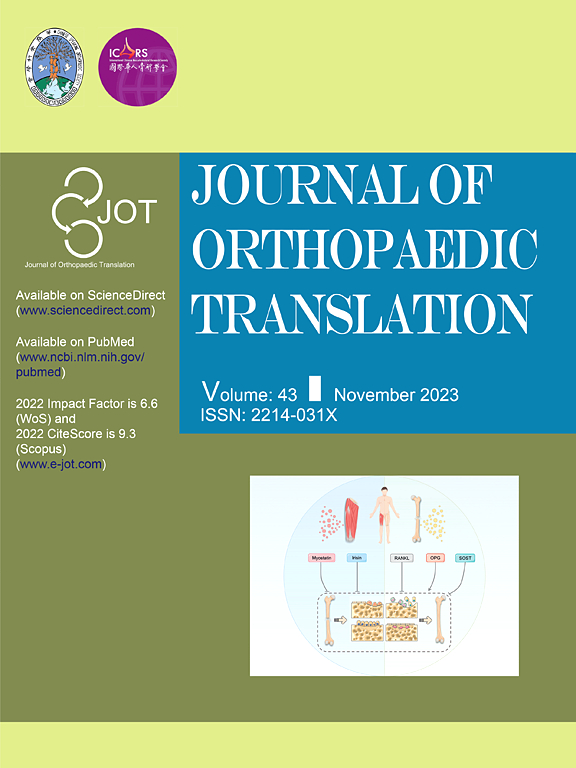骨适应的性别依赖性变异:从退化到再生
IF 5.9
1区 医学
Q1 ORTHOPEDICS
引用次数: 0
摘要
虽然已知存在骨骼健康的性别差异,但关于骨骼退化和再生的科学研究经常忽视性别影响作为结果的变量。有证据表明,与男性相比,女性患骨质疏松症的风险更高,骨质退化率也更高。越来越多的研究表明,这种差异也存在于骨再生和修复中。然而,目前在这一领域还没有全面的综述来强调性别的影响。本文旨在回顾目前可获得的关于骨骼性别二态现象背后的细胞机制的信息,具体到激素和骨骼的退行性和再生性差异。这篇综述将讨论考虑到性别的个性化再生疗法的优化。该综述强调,性别影响必须进一步研究,以推进骨再生领域,改善患者的预后和生活质量。由于转化医学是JOT的重点,作者必须在摘要和讨论中强调其工作的转化潜力或临床意义。为此,需要在摘要(包含在摘要字数统计中)后面加上如下标题的说明:“本文的翻译潜力”。2. 请按照以下原则重新编辑参考文献列表:1)应包括所有作者的姓氏和首字母缩写,但当作者人数为7名或更多时,仅列出前6名作者,后面加“et al”;2)删除参考文献列表中的“[英文]”(如有);3)参考标准期刊文章(请特别注意格式、字母大写、间距和风格):“Niemansburg SL, van Delden JJ, Dhert WJ, Bredenoord AL.骨科疾病的再生医学干预:翻译给患者的伦理问题。”中华医学杂志2013;8:65-73。本文章由计算机程序翻译,如有差异,请以英文原文为准。

Sex-dependent variation in bone adaptation: from degeneration to regeneration
While known sex differences in bone health exist, scientific studies on bone degeneration and regeneration frequently disregard sex impact as a variable in outcomes. Evidence has established a higher risk of osteoporosis and increased bone degradation rates in women when compared to men. Accumulating research suggests that this disparity is also present in bone regeneration and repair. However, no comprehensive review highlighting the influence of sex currently exists in this field. This paper aims to review the information presently available on the cellular mechanisms behind skeletal sexual dimorphism specific to hormones and bone's degenerative and regenerative sex differences. This review will discuss the optimization of personalized regenerative therapies accounting for sex. The review emphasizes that sex impact must further be investigated to advance the field of bone regeneration and improve patient outcomes and quality of life.
As translational medicine is JOT's focus, authors must highlight the translational potential or clinical significance of their work in both the abstract and the discussion. To this effect, it is required to include a statement following the abstract (included in the abstract word count) under the following heading: "The Translational Potential of this Article". 2. Please re-edit the reference list according to the following guidelines: 1) The last names and initials of all the authors up to 6 should be included, but when authors number 7 or more, list the first 6 authors only followed by 'et al'; 2) The "[eng]" in the reference list should be removed (if any); 3) Reference to a standard journal article (Please pay particular attention to the formatting, word capitalization, spacing and style): “Niemansburg SL, van Delden JJ, Dhert WJ, Bredenoord AL. Regenerative medicine interventions for orthopedic disorders: ethical issues in the translation into patients. Regen Med 2013;8:65–73.
求助全文
通过发布文献求助,成功后即可免费获取论文全文。
去求助
来源期刊

Journal of Orthopaedic Translation
Medicine-Orthopedics and Sports Medicine
CiteScore
11.80
自引率
13.60%
发文量
91
审稿时长
29 days
期刊介绍:
The Journal of Orthopaedic Translation (JOT) is the official peer-reviewed, open access journal of the Chinese Speaking Orthopaedic Society (CSOS) and the International Chinese Musculoskeletal Research Society (ICMRS). It is published quarterly, in January, April, July and October, by Elsevier.
 求助内容:
求助内容: 应助结果提醒方式:
应助结果提醒方式:


